BMW's International Market Entry Strategy: A Marketing Report Analysis
VerifiedAdded on 2020/12/10
|11
|1729
|481
Report
AI Summary
This report provides a comprehensive analysis of BMW's international marketing strategy, focusing on its expansion into the Korean market. It begins with an introduction to international marketing, defining its scope and rationale for BMW's global ambitions. The report then delves into the core concepts of global versus local markets, outlining their key differences and implications for business operations. A significant portion of the report is dedicated to examining BMW's approach to product, pricing, promotion, and distribution strategies within the context of the Korean market, providing insights into how BMW can effectively tailor its marketing mix. Furthermore, the report explores different international marketing approaches, such as centralized and decentralized strategies, recommending the most suitable approach for BMW's international endeavors. Finally, it compares home market (UK) and international market orientations, highlighting the challenges and opportunities associated with global expansion. The report concludes by summarizing key findings and referencing relevant academic sources.
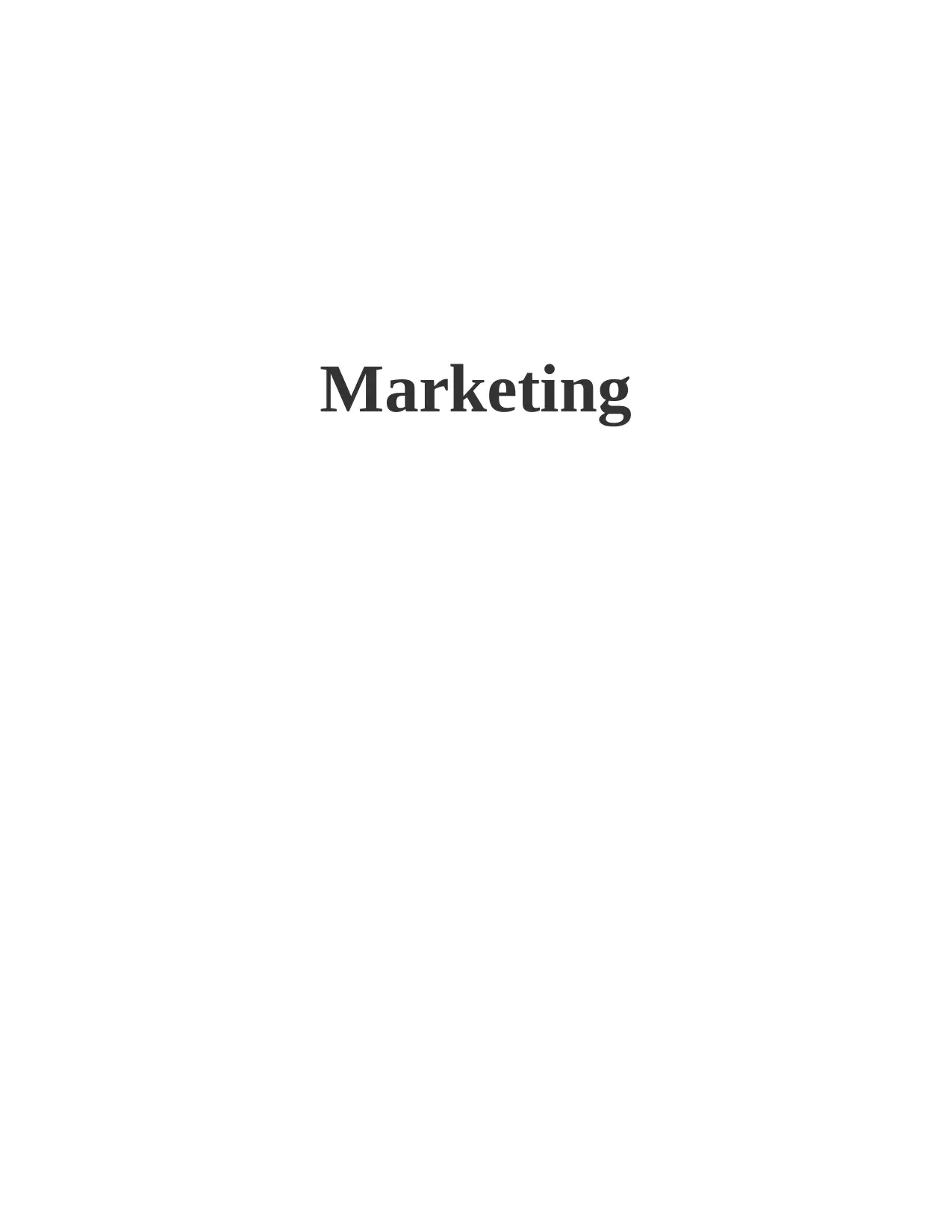
Marketing
Paraphrase This Document
Need a fresh take? Get an instant paraphrase of this document with our AI Paraphraser
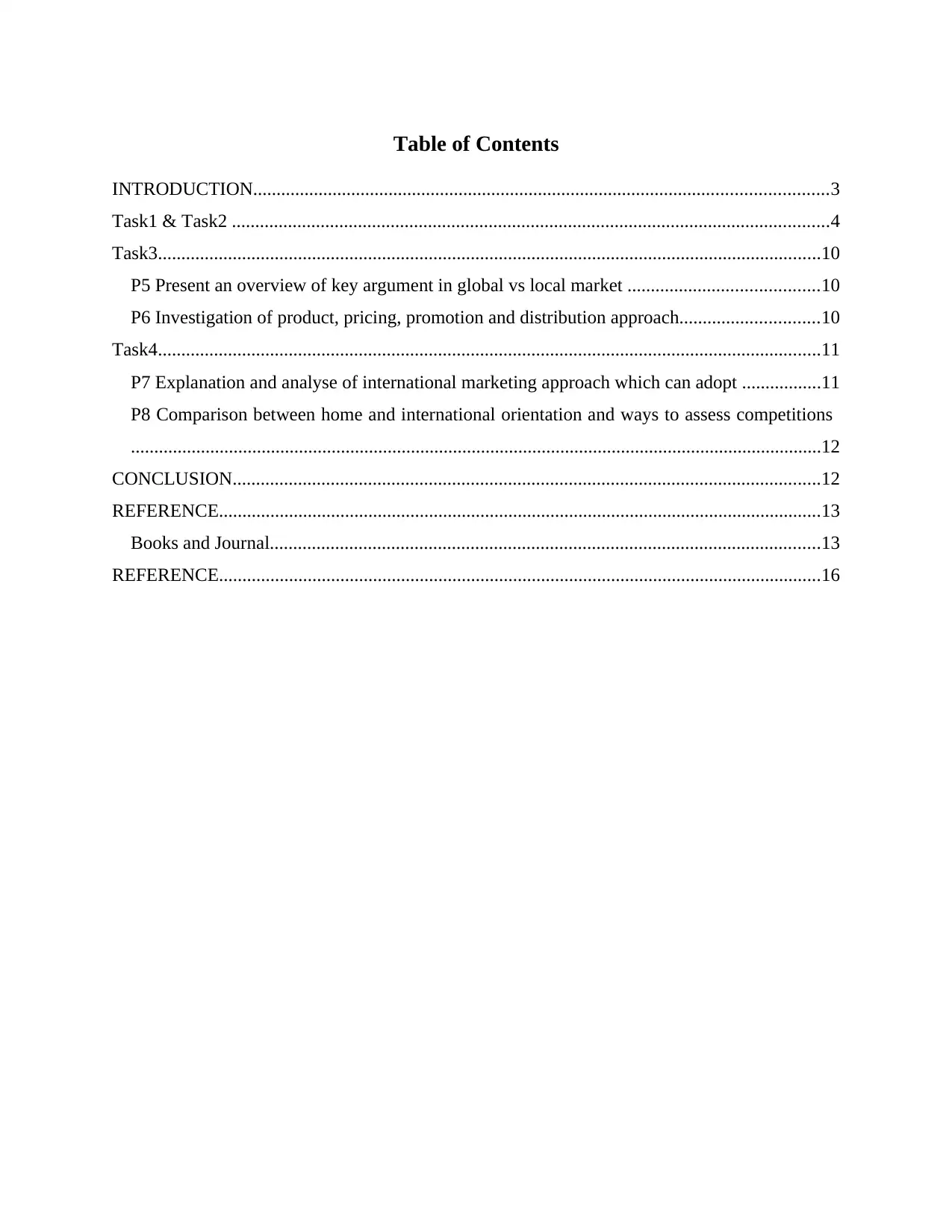
Table of Contents
INTRODUCTION...........................................................................................................................3
Task1 & Task2 ................................................................................................................................4
Task3..............................................................................................................................................10
P5 Present an overview of key argument in global vs local market .........................................10
P6 Investigation of product, pricing, promotion and distribution approach..............................10
Task4..............................................................................................................................................11
P7 Explanation and analyse of international marketing approach which can adopt .................11
P8 Comparison between home and international orientation and ways to assess competitions
....................................................................................................................................................12
CONCLUSION..............................................................................................................................12
REFERENCE.................................................................................................................................13
Books and Journal......................................................................................................................13
REFERENCE.................................................................................................................................16
INTRODUCTION...........................................................................................................................3
Task1 & Task2 ................................................................................................................................4
Task3..............................................................................................................................................10
P5 Present an overview of key argument in global vs local market .........................................10
P6 Investigation of product, pricing, promotion and distribution approach..............................10
Task4..............................................................................................................................................11
P7 Explanation and analyse of international marketing approach which can adopt .................11
P8 Comparison between home and international orientation and ways to assess competitions
....................................................................................................................................................12
CONCLUSION..............................................................................................................................12
REFERENCE.................................................................................................................................13
Books and Journal......................................................................................................................13
REFERENCE.................................................................................................................................16
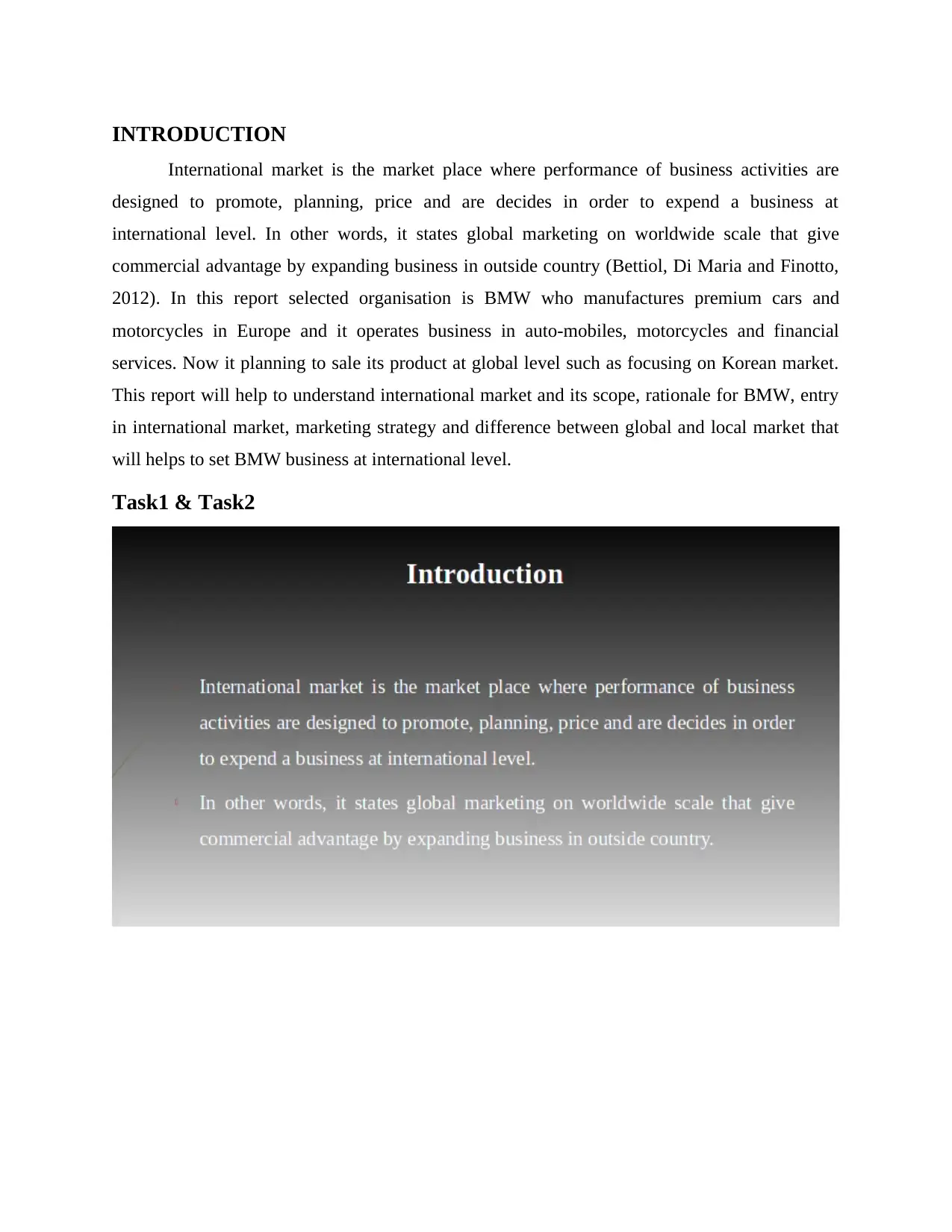
INTRODUCTION
International market is the market place where performance of business activities are
designed to promote, planning, price and are decides in order to expend a business at
international level. In other words, it states global marketing on worldwide scale that give
commercial advantage by expanding business in outside country (Bettiol, Di Maria and Finotto,
2012). In this report selected organisation is BMW who manufactures premium cars and
motorcycles in Europe and it operates business in auto-mobiles, motorcycles and financial
services. Now it planning to sale its product at global level such as focusing on Korean market.
This report will help to understand international market and its scope, rationale for BMW, entry
in international market, marketing strategy and difference between global and local market that
will helps to set BMW business at international level.
Task1 & Task2
International market is the market place where performance of business activities are
designed to promote, planning, price and are decides in order to expend a business at
international level. In other words, it states global marketing on worldwide scale that give
commercial advantage by expanding business in outside country (Bettiol, Di Maria and Finotto,
2012). In this report selected organisation is BMW who manufactures premium cars and
motorcycles in Europe and it operates business in auto-mobiles, motorcycles and financial
services. Now it planning to sale its product at global level such as focusing on Korean market.
This report will help to understand international market and its scope, rationale for BMW, entry
in international market, marketing strategy and difference between global and local market that
will helps to set BMW business at international level.
Task1 & Task2
⊘ This is a preview!⊘
Do you want full access?
Subscribe today to unlock all pages.

Trusted by 1+ million students worldwide
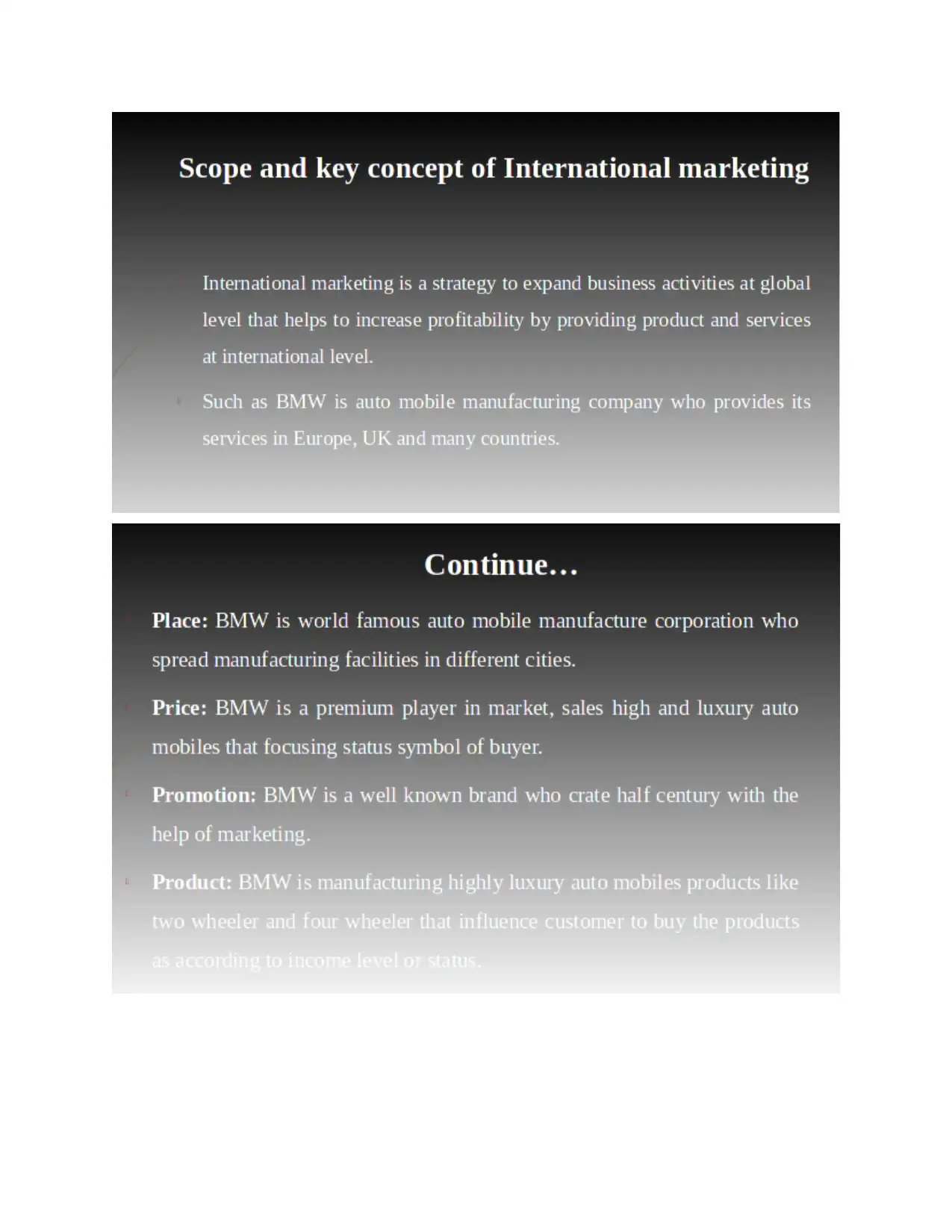
Paraphrase This Document
Need a fresh take? Get an instant paraphrase of this document with our AI Paraphraser
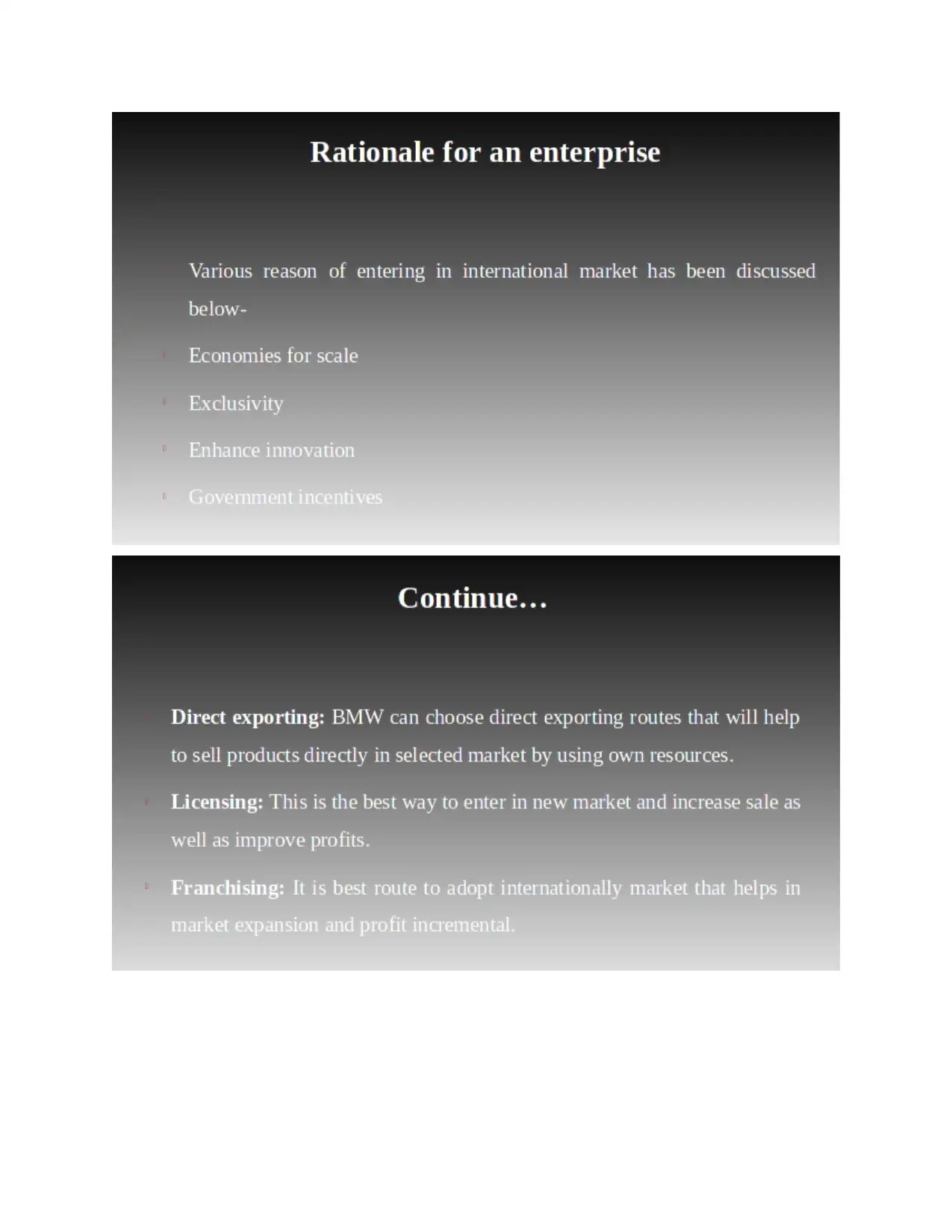
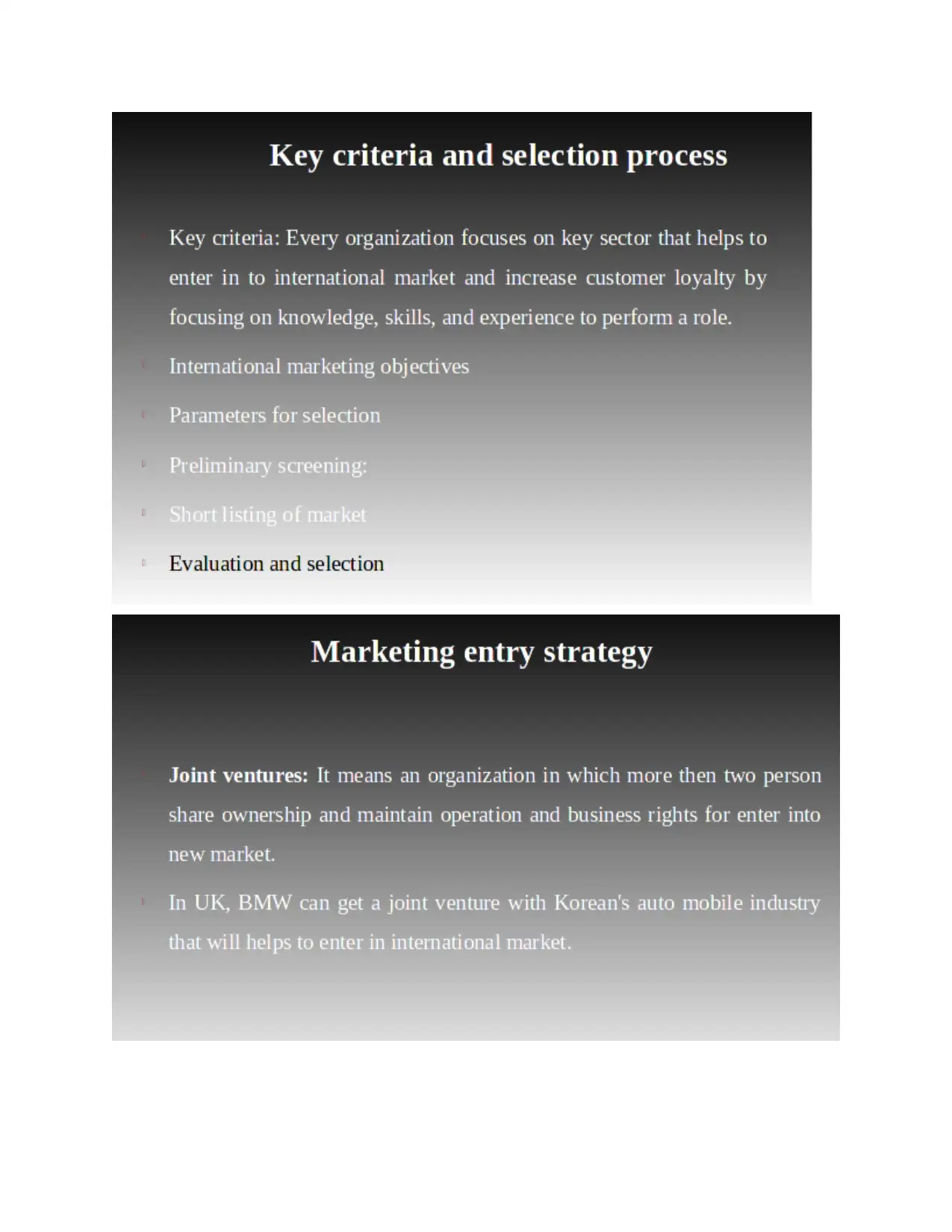
⊘ This is a preview!⊘
Do you want full access?
Subscribe today to unlock all pages.

Trusted by 1+ million students worldwide
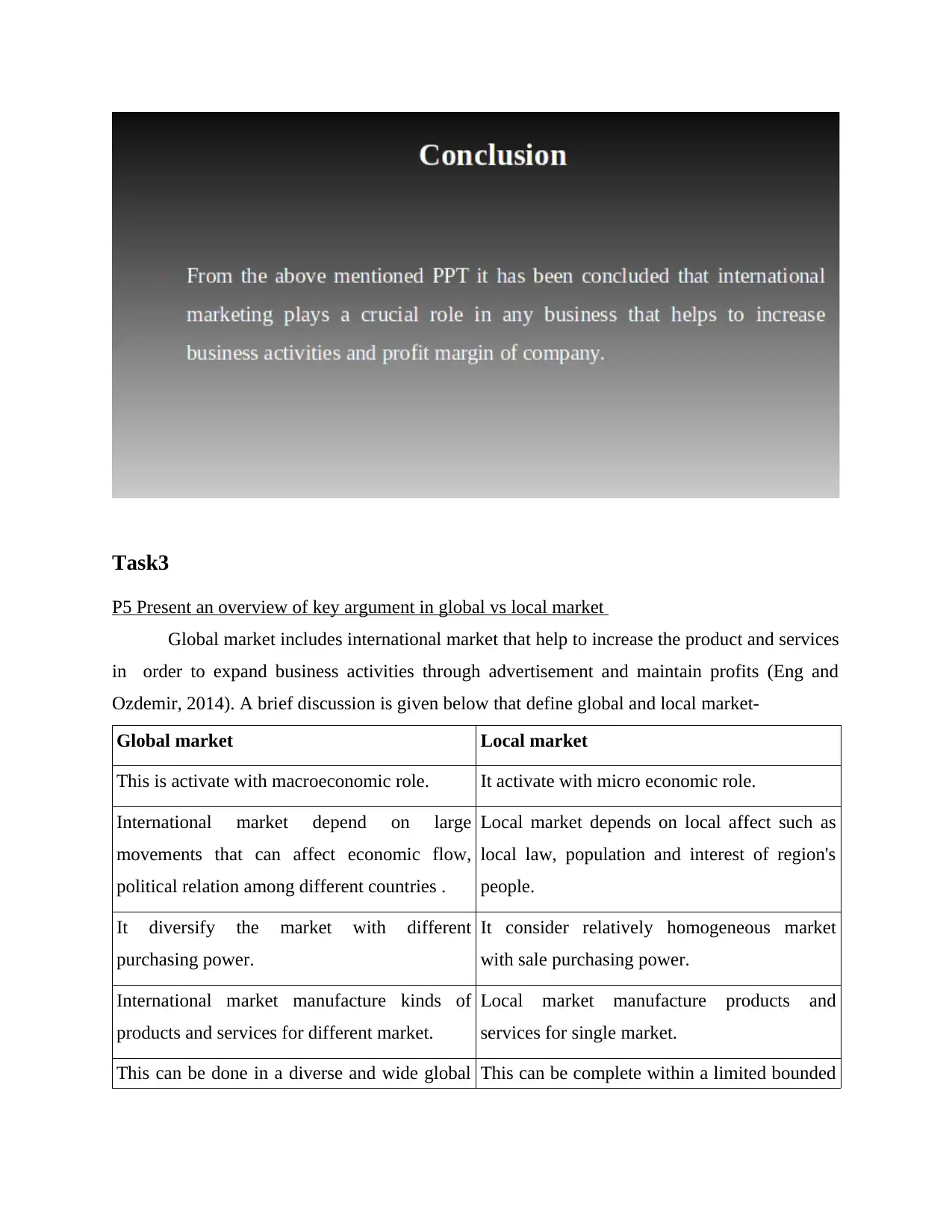
Task3
P5 Present an overview of key argument in global vs local market
Global market includes international market that help to increase the product and services
in order to expand business activities through advertisement and maintain profits (Eng and
Ozdemir, 2014). A brief discussion is given below that define global and local market-
Global market Local market
This is activate with macroeconomic role. It activate with micro economic role.
International market depend on large
movements that can affect economic flow,
political relation among different countries .
Local market depends on local affect such as
local law, population and interest of region's
people.
It diversify the market with different
purchasing power.
It consider relatively homogeneous market
with sale purchasing power.
International market manufacture kinds of
products and services for different market.
Local market manufacture products and
services for single market.
This can be done in a diverse and wide global This can be complete within a limited bounded
P5 Present an overview of key argument in global vs local market
Global market includes international market that help to increase the product and services
in order to expand business activities through advertisement and maintain profits (Eng and
Ozdemir, 2014). A brief discussion is given below that define global and local market-
Global market Local market
This is activate with macroeconomic role. It activate with micro economic role.
International market depend on large
movements that can affect economic flow,
political relation among different countries .
Local market depends on local affect such as
local law, population and interest of region's
people.
It diversify the market with different
purchasing power.
It consider relatively homogeneous market
with sale purchasing power.
International market manufacture kinds of
products and services for different market.
Local market manufacture products and
services for single market.
This can be done in a diverse and wide global This can be complete within a limited bounded
Paraphrase This Document
Need a fresh take? Get an instant paraphrase of this document with our AI Paraphraser
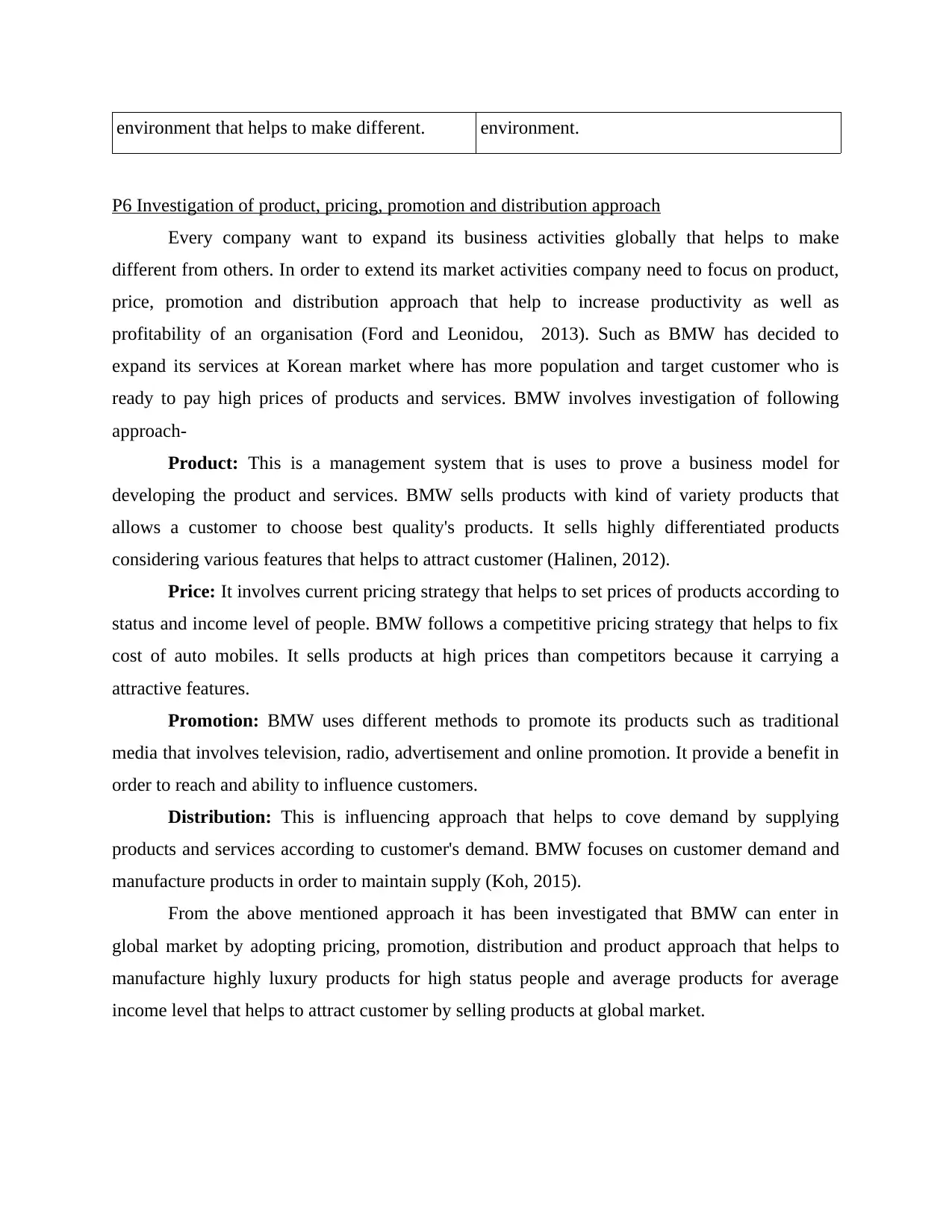
environment that helps to make different. environment.
P6 Investigation of product, pricing, promotion and distribution approach
Every company want to expand its business activities globally that helps to make
different from others. In order to extend its market activities company need to focus on product,
price, promotion and distribution approach that help to increase productivity as well as
profitability of an organisation (Ford and Leonidou, 2013). Such as BMW has decided to
expand its services at Korean market where has more population and target customer who is
ready to pay high prices of products and services. BMW involves investigation of following
approach-
Product: This is a management system that is uses to prove a business model for
developing the product and services. BMW sells products with kind of variety products that
allows a customer to choose best quality's products. It sells highly differentiated products
considering various features that helps to attract customer (Halinen, 2012).
Price: It involves current pricing strategy that helps to set prices of products according to
status and income level of people. BMW follows a competitive pricing strategy that helps to fix
cost of auto mobiles. It sells products at high prices than competitors because it carrying a
attractive features.
Promotion: BMW uses different methods to promote its products such as traditional
media that involves television, radio, advertisement and online promotion. It provide a benefit in
order to reach and ability to influence customers.
Distribution: This is influencing approach that helps to cove demand by supplying
products and services according to customer's demand. BMW focuses on customer demand and
manufacture products in order to maintain supply (Koh, 2015).
From the above mentioned approach it has been investigated that BMW can enter in
global market by adopting pricing, promotion, distribution and product approach that helps to
manufacture highly luxury products for high status people and average products for average
income level that helps to attract customer by selling products at global market.
P6 Investigation of product, pricing, promotion and distribution approach
Every company want to expand its business activities globally that helps to make
different from others. In order to extend its market activities company need to focus on product,
price, promotion and distribution approach that help to increase productivity as well as
profitability of an organisation (Ford and Leonidou, 2013). Such as BMW has decided to
expand its services at Korean market where has more population and target customer who is
ready to pay high prices of products and services. BMW involves investigation of following
approach-
Product: This is a management system that is uses to prove a business model for
developing the product and services. BMW sells products with kind of variety products that
allows a customer to choose best quality's products. It sells highly differentiated products
considering various features that helps to attract customer (Halinen, 2012).
Price: It involves current pricing strategy that helps to set prices of products according to
status and income level of people. BMW follows a competitive pricing strategy that helps to fix
cost of auto mobiles. It sells products at high prices than competitors because it carrying a
attractive features.
Promotion: BMW uses different methods to promote its products such as traditional
media that involves television, radio, advertisement and online promotion. It provide a benefit in
order to reach and ability to influence customers.
Distribution: This is influencing approach that helps to cove demand by supplying
products and services according to customer's demand. BMW focuses on customer demand and
manufacture products in order to maintain supply (Koh, 2015).
From the above mentioned approach it has been investigated that BMW can enter in
global market by adopting pricing, promotion, distribution and product approach that helps to
manufacture highly luxury products for high status people and average products for average
income level that helps to attract customer by selling products at global market.
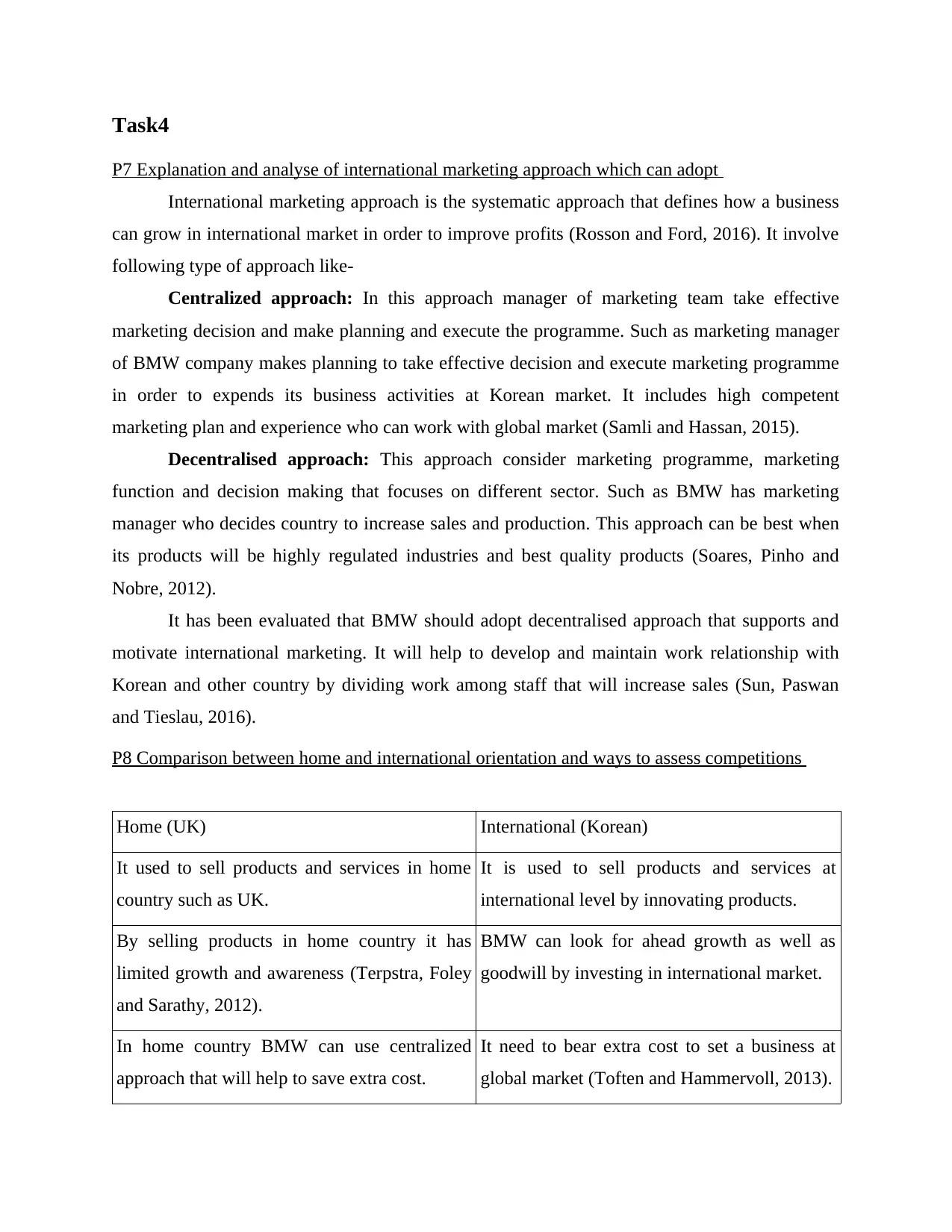
Task4
P7 Explanation and analyse of international marketing approach which can adopt
International marketing approach is the systematic approach that defines how a business
can grow in international market in order to improve profits (Rosson and Ford, 2016). It involve
following type of approach like-
Centralized approach: In this approach manager of marketing team take effective
marketing decision and make planning and execute the programme. Such as marketing manager
of BMW company makes planning to take effective decision and execute marketing programme
in order to expends its business activities at Korean market. It includes high competent
marketing plan and experience who can work with global market (Samli and Hassan, 2015).
Decentralised approach: This approach consider marketing programme, marketing
function and decision making that focuses on different sector. Such as BMW has marketing
manager who decides country to increase sales and production. This approach can be best when
its products will be highly regulated industries and best quality products (Soares, Pinho and
Nobre, 2012).
It has been evaluated that BMW should adopt decentralised approach that supports and
motivate international marketing. It will help to develop and maintain work relationship with
Korean and other country by dividing work among staff that will increase sales (Sun, Paswan
and Tieslau, 2016).
P8 Comparison between home and international orientation and ways to assess competitions
Home (UK) International (Korean)
It used to sell products and services in home
country such as UK.
It is used to sell products and services at
international level by innovating products.
By selling products in home country it has
limited growth and awareness (Terpstra, Foley
and Sarathy, 2012).
BMW can look for ahead growth as well as
goodwill by investing in international market.
In home country BMW can use centralized
approach that will help to save extra cost.
It need to bear extra cost to set a business at
global market (Toften and Hammervoll, 2013).
P7 Explanation and analyse of international marketing approach which can adopt
International marketing approach is the systematic approach that defines how a business
can grow in international market in order to improve profits (Rosson and Ford, 2016). It involve
following type of approach like-
Centralized approach: In this approach manager of marketing team take effective
marketing decision and make planning and execute the programme. Such as marketing manager
of BMW company makes planning to take effective decision and execute marketing programme
in order to expends its business activities at Korean market. It includes high competent
marketing plan and experience who can work with global market (Samli and Hassan, 2015).
Decentralised approach: This approach consider marketing programme, marketing
function and decision making that focuses on different sector. Such as BMW has marketing
manager who decides country to increase sales and production. This approach can be best when
its products will be highly regulated industries and best quality products (Soares, Pinho and
Nobre, 2012).
It has been evaluated that BMW should adopt decentralised approach that supports and
motivate international marketing. It will help to develop and maintain work relationship with
Korean and other country by dividing work among staff that will increase sales (Sun, Paswan
and Tieslau, 2016).
P8 Comparison between home and international orientation and ways to assess competitions
Home (UK) International (Korean)
It used to sell products and services in home
country such as UK.
It is used to sell products and services at
international level by innovating products.
By selling products in home country it has
limited growth and awareness (Terpstra, Foley
and Sarathy, 2012).
BMW can look for ahead growth as well as
goodwill by investing in international market.
In home country BMW can use centralized
approach that will help to save extra cost.
It need to bear extra cost to set a business at
global market (Toften and Hammervoll, 2013).
⊘ This is a preview!⊘
Do you want full access?
Subscribe today to unlock all pages.

Trusted by 1+ million students worldwide
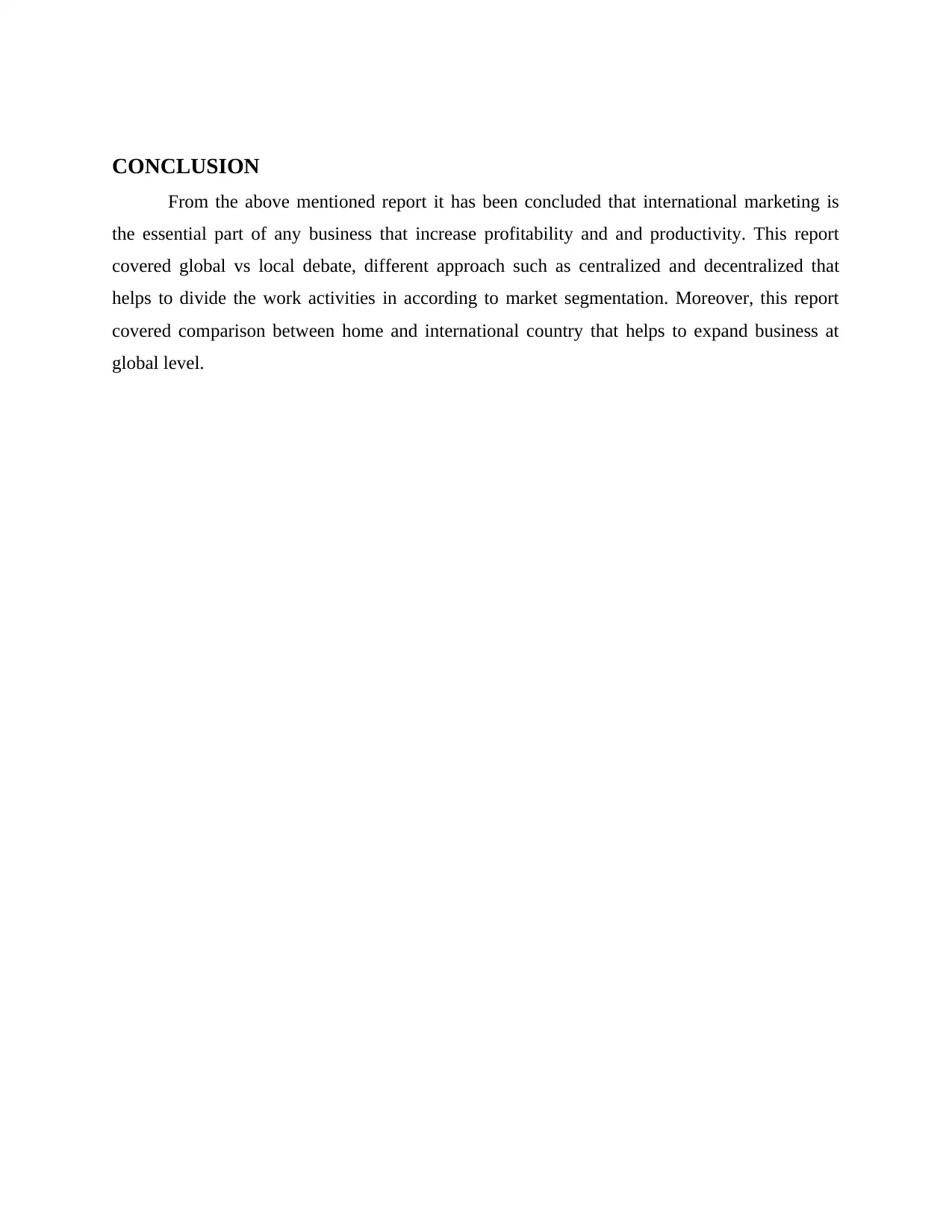
CONCLUSION
From the above mentioned report it has been concluded that international marketing is
the essential part of any business that increase profitability and and productivity. This report
covered global vs local debate, different approach such as centralized and decentralized that
helps to divide the work activities in according to market segmentation. Moreover, this report
covered comparison between home and international country that helps to expand business at
global level.
From the above mentioned report it has been concluded that international marketing is
the essential part of any business that increase profitability and and productivity. This report
covered global vs local debate, different approach such as centralized and decentralized that
helps to divide the work activities in according to market segmentation. Moreover, this report
covered comparison between home and international country that helps to expand business at
global level.
Paraphrase This Document
Need a fresh take? Get an instant paraphrase of this document with our AI Paraphraser
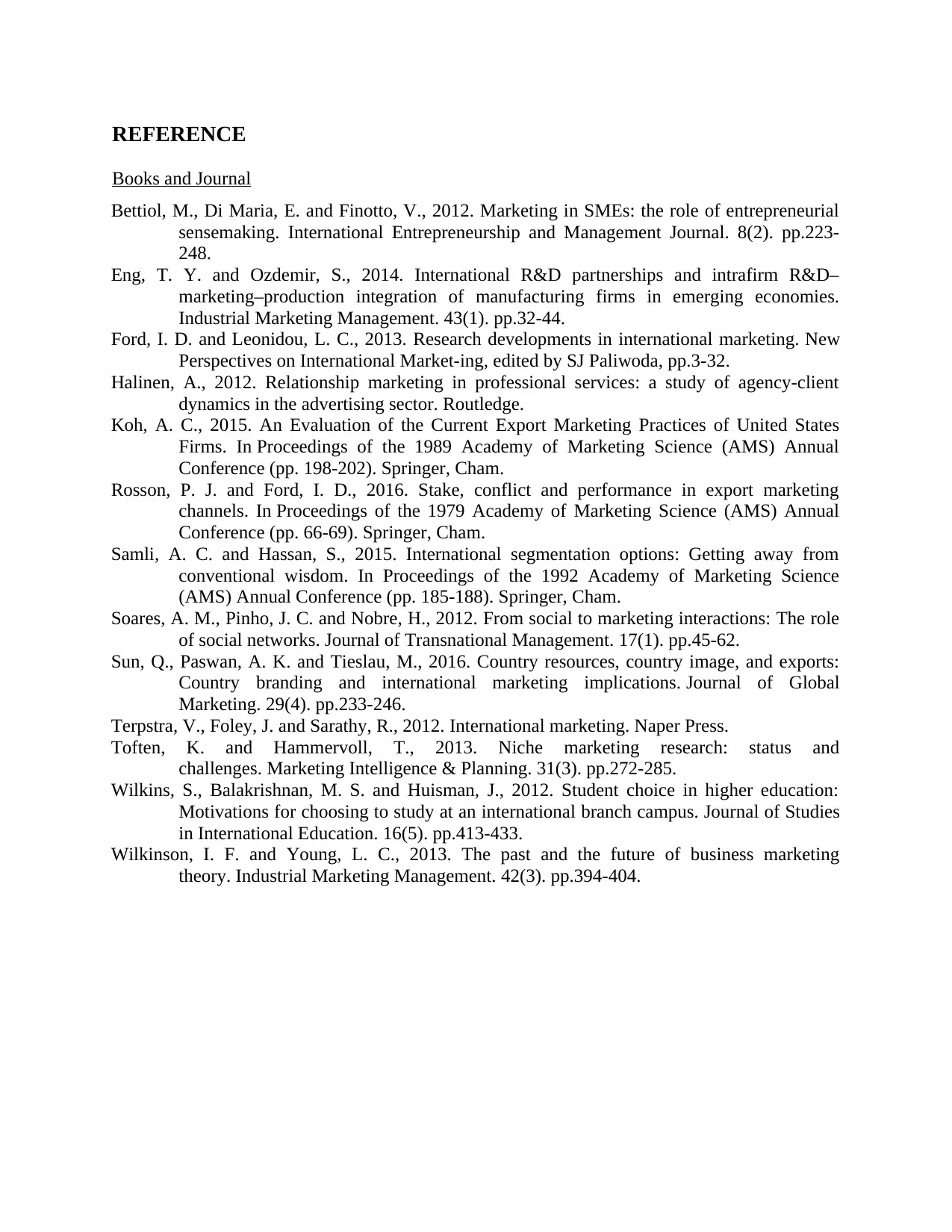
REFERENCE
Books and Journal
Bettiol, M., Di Maria, E. and Finotto, V., 2012. Marketing in SMEs: the role of entrepreneurial
sensemaking. International Entrepreneurship and Management Journal. 8(2). pp.223-
248.
Eng, T. Y. and Ozdemir, S., 2014. International R&D partnerships and intrafirm R&D–
marketing–production integration of manufacturing firms in emerging economies.
Industrial Marketing Management. 43(1). pp.32-44.
Ford, I. D. and Leonidou, L. C., 2013. Research developments in international marketing. New
Perspectives on International Market-ing, edited by SJ Paliwoda, pp.3-32.
Halinen, A., 2012. Relationship marketing in professional services: a study of agency-client
dynamics in the advertising sector. Routledge.
Koh, A. C., 2015. An Evaluation of the Current Export Marketing Practices of United States
Firms. In Proceedings of the 1989 Academy of Marketing Science (AMS) Annual
Conference (pp. 198-202). Springer, Cham.
Rosson, P. J. and Ford, I. D., 2016. Stake, conflict and performance in export marketing
channels. In Proceedings of the 1979 Academy of Marketing Science (AMS) Annual
Conference (pp. 66-69). Springer, Cham.
Samli, A. C. and Hassan, S., 2015. International segmentation options: Getting away from
conventional wisdom. In Proceedings of the 1992 Academy of Marketing Science
(AMS) Annual Conference (pp. 185-188). Springer, Cham.
Soares, A. M., Pinho, J. C. and Nobre, H., 2012. From social to marketing interactions: The role
of social networks. Journal of Transnational Management. 17(1). pp.45-62.
Sun, Q., Paswan, A. K. and Tieslau, M., 2016. Country resources, country image, and exports:
Country branding and international marketing implications. Journal of Global
Marketing. 29(4). pp.233-246.
Terpstra, V., Foley, J. and Sarathy, R., 2012. International marketing. Naper Press.
Toften, K. and Hammervoll, T., 2013. Niche marketing research: status and
challenges. Marketing Intelligence & Planning. 31(3). pp.272-285.
Wilkins, S., Balakrishnan, M. S. and Huisman, J., 2012. Student choice in higher education:
Motivations for choosing to study at an international branch campus. Journal of Studies
in International Education. 16(5). pp.413-433.
Wilkinson, I. F. and Young, L. C., 2013. The past and the future of business marketing
theory. Industrial Marketing Management. 42(3). pp.394-404.
Books and Journal
Bettiol, M., Di Maria, E. and Finotto, V., 2012. Marketing in SMEs: the role of entrepreneurial
sensemaking. International Entrepreneurship and Management Journal. 8(2). pp.223-
248.
Eng, T. Y. and Ozdemir, S., 2014. International R&D partnerships and intrafirm R&D–
marketing–production integration of manufacturing firms in emerging economies.
Industrial Marketing Management. 43(1). pp.32-44.
Ford, I. D. and Leonidou, L. C., 2013. Research developments in international marketing. New
Perspectives on International Market-ing, edited by SJ Paliwoda, pp.3-32.
Halinen, A., 2012. Relationship marketing in professional services: a study of agency-client
dynamics in the advertising sector. Routledge.
Koh, A. C., 2015. An Evaluation of the Current Export Marketing Practices of United States
Firms. In Proceedings of the 1989 Academy of Marketing Science (AMS) Annual
Conference (pp. 198-202). Springer, Cham.
Rosson, P. J. and Ford, I. D., 2016. Stake, conflict and performance in export marketing
channels. In Proceedings of the 1979 Academy of Marketing Science (AMS) Annual
Conference (pp. 66-69). Springer, Cham.
Samli, A. C. and Hassan, S., 2015. International segmentation options: Getting away from
conventional wisdom. In Proceedings of the 1992 Academy of Marketing Science
(AMS) Annual Conference (pp. 185-188). Springer, Cham.
Soares, A. M., Pinho, J. C. and Nobre, H., 2012. From social to marketing interactions: The role
of social networks. Journal of Transnational Management. 17(1). pp.45-62.
Sun, Q., Paswan, A. K. and Tieslau, M., 2016. Country resources, country image, and exports:
Country branding and international marketing implications. Journal of Global
Marketing. 29(4). pp.233-246.
Terpstra, V., Foley, J. and Sarathy, R., 2012. International marketing. Naper Press.
Toften, K. and Hammervoll, T., 2013. Niche marketing research: status and
challenges. Marketing Intelligence & Planning. 31(3). pp.272-285.
Wilkins, S., Balakrishnan, M. S. and Huisman, J., 2012. Student choice in higher education:
Motivations for choosing to study at an international branch campus. Journal of Studies
in International Education. 16(5). pp.413-433.
Wilkinson, I. F. and Young, L. C., 2013. The past and the future of business marketing
theory. Industrial Marketing Management. 42(3). pp.394-404.
1 out of 11
Related Documents
Your All-in-One AI-Powered Toolkit for Academic Success.
+13062052269
info@desklib.com
Available 24*7 on WhatsApp / Email
![[object Object]](/_next/static/media/star-bottom.7253800d.svg)
Unlock your academic potential
Copyright © 2020–2025 A2Z Services. All Rights Reserved. Developed and managed by ZUCOL.




